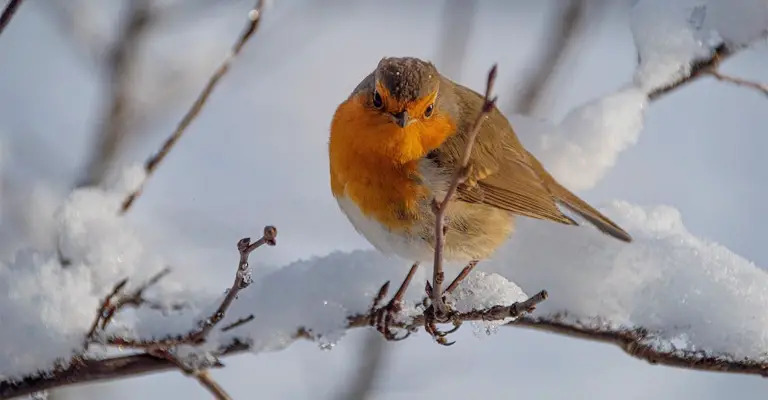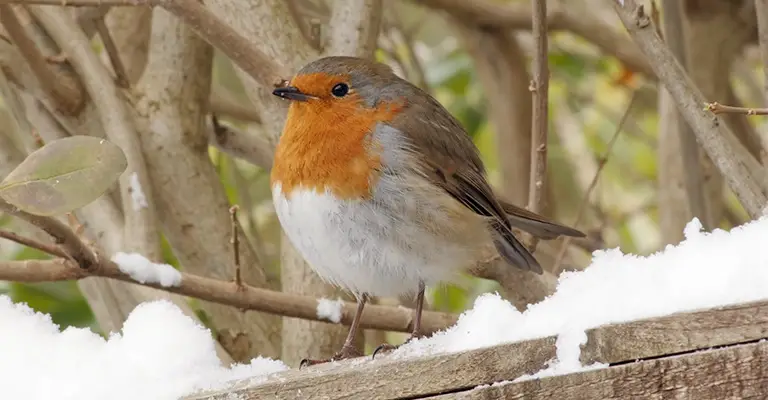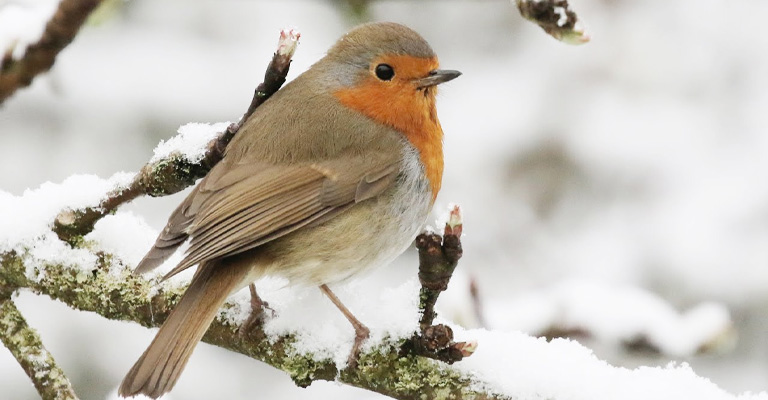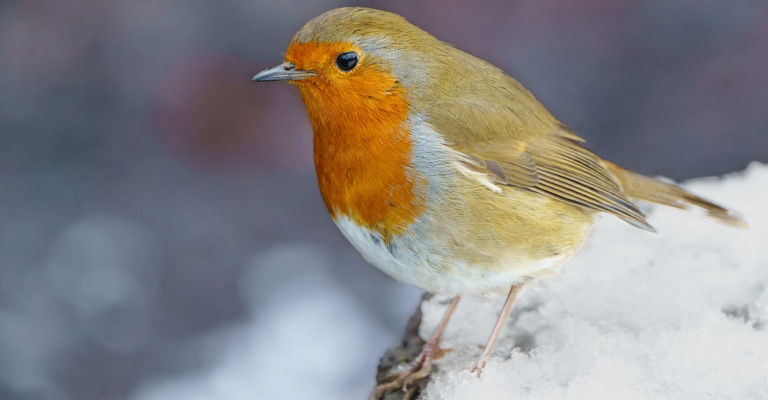As winter blankets the European landscape in a tranquil, icy embrace, a small yet vibrant creature emerges as an emblem of this cold, enchanting season—the European Robin. With its fiery red breast, this feathered friend has long captured the imagination of cultures across Europe, becoming an enduring symbol of winter.
But why is the European Robin associated with this frosty time of year? In this blog post, we embark on a journey to uncover the fascinating reasons behind this avian connection to winter.
Beyond its striking appearance, the European Robin’s year-round presence, resilience, and timeless role in folklore play a pivotal role in shaping its symbolic significance.
From tales of Christmas miracles to its association with warmth and comfort, Robin’s story is one of hope and continuity amid the chill of winter.

Why is the European Robin Associated with Winter?
The European Robin (Erithacus Rubecula) is often associated with winter in European folklore and culture for several reasons:
Red Breast
The most distinctive feature of the European Robin is its bright orange-red breast. This striking coloration stands out against the white snow of winter, making the bird highly visible during the colder months.
This association of red with warmth and color in an otherwise drab winter landscape likely contributed to its symbolic significance.
Year-round Resident
Unlike many migratory birds that leave Europe for warmer climates during the winter, European Robins are known to remain in their breeding territories throughout the year.
They are one of the few birds that can be seen in gardens and woodlands during the winter months, providing a sense of continuity and familiarity in the midst of a season that can be harsh and unforgiving.
Folklore and Literature
European Robins have been featured in various folklore and literary traditions. In European folklore, they were sometimes seen as birds that brought warmth and comfort to people during winter, and there were superstitions that harming a Robin would bring bad luck.
Additionally, they were sometimes associated with the spirit of loved ones returning, which is reflected in the phrase “the Robin redbreast is a sign of a soul departed.”
Christmas Symbolism
In some parts of Europe, the European Robin has been associated with Christmas. One legend tells of a Robin that sang over the baby Jesus in the manger to keep him warm, and its breast turned red from the heat. This legend contributed to the bird’s association with the holiday season.
Behavior
European Robins are known for their territorial behavior and boldness, often approaching humans closely.
This behavior becomes more apparent in winter when food is scarcer, and they may venture closer to human settlements, making them more noticeable during this season.
The European Robin is associated with winter due to its distinctive appearance, year-round presence in Europe, cultural symbolism, and historical folklore.
Its presence during the colder months has made it a symbol of hope and continuity in the face of winter’s challenges.
How Robins Became a Symbol of Christmas

The European Robin (Erithacus Rubecula) became a symbol of Christmas through a combination of folklore, legend, and cultural associations. The bird’s connection to Christmas is particularly strong in British and European traditions.
Here are some key factors that contributed to the Robin’s association with Christmas:
Legend of the Christmas Robin
One of the most popular legends involves a Robin that sang over the baby Jesus in the manger to keep him warm with its song. As the Robin flapped its wings to provide warmth, a single drop of blood from its breast fell on the baby’s forehead.
This act of kindness turned the Robin’s breast red, symbolizing the bird’s sacrifice and compassion. This legend has strong Christian symbolism, connecting the Robin to the birth of Christ and the spirit of giving and selflessness associated with Christmas.
Red Breast Symbolism
The bright red-orange breast of the European Robin has long been associated with warmth and comfort. In the context of Christmas, it symbolizes the warmth and love shared during the holiday season, even in the coldest of winter months.
The red breast of the Robin stands out against the white snow, making it a visual representation of hope and renewal during winter.
Christmas Cards and Decorations
In the 19th century, the practice of sending Christmas cards became popular in Britain. Many of these early Christmas cards featured images of Robins alongside festive scenes.
The Robin’s appearance in these cards helped cement its association with Christmas. Additionally, Robins often appear on Christmas tree ornaments and other decorations.
Folklore and Chrismas Poetry
Robins have been featured in numerous poems and songs associated with Christmas. Their inclusion in these cultural expressions has contributed to their status as a symbol of the holiday.
For example, the popular Christmas carol “The Robin’s Christmas Song” celebrates Robin’s role in the Nativity story.
The European Robin’s association with Christmas is a product of its red breast, its presence during the winter, its role in legends and stories, and its appearance in cultural expressions related to the holiday.
Over time, these factors combined to firmly establish the Robin as a beloved and enduring symbol of Christmas, representing the themes of love, warmth, and hope associated with the season.
Robin’s Connection with Winter

The European Robin is indeed strongly associated with winter in European culture and symbolism. Here are some additional details about the Robin’s connection with winter:
Winter Resilience
European Robins are known for their resilience during the winter months. They do not migrate to warmer climates like many other bird species. Instead, they stay in their territories, facing the harsh conditions of winter.
This behavior highlights their ability to endure and adapt to the cold, making them a symbol of strength and survival during the toughest season of the year.
Winter Appearance
The European Robin’s appearance, with its bright red-orange breast, is particularly striking against the winter backdrop of snow and bare trees. This contrast makes the Robin more visible and easily recognizable during the winter months, further solidifying its association with the season.
Christmas Connection
In British and European Christmas traditions, the European Robin has been linked to the holiday season. It’s sometimes referred to as the “Christmas Robin” or “Robin Redbreast.”
One popular legend suggests that the Robin got its red breast from a splash of Jesus’ blood when it tried to remove a thorn from the crown of thorns on Jesus’ head during the Crucifixion.
This connection to the story of Jesus and the timing of Christmas contributes to Robin’s role as a symbol of hope, renewal, and the spirit of giving during the winter holidays.
Symbol of Good Luck
In some cultures, the sighting of a Robin during winter is considered a sign of good luck and a harbinger of positive things to come. This belief further enhances Robin’s association with winter and its potential for bringing warmth and fortune during the cold season.
Cultural Depictions
The European Robin has appeared in various forms of art, literature, and folklore associated with winter. Its presence in poems, songs, and holiday decorations reinforces its symbolism as a winter icon.
The European Robin’s strong ties to winter stem from its physical characteristics, its resilience during the season, and the various cultural and symbolic associations that have developed over centuries in Europe.
This bird has become an enduring symbol of hope, comfort, and beauty that can be found even in the coldest and darkest of times.
Robin’s Behavioral Changes in Winter

European Robins exhibit several behavioral changes during the winter months as they adapt to the challenges of colder weather and scarcer food resources. Here are some key behavioral changes observed in European Robins during winter:
Territorial Behavior
Robins are territorial birds, and during the winter, they defend their territories vigorously. This territorial behavior is especially evident when it comes to food sources.
Robins will defend feeding areas and are known for their aggression toward other birds, even those of their own species, that encroach on their winter territories.
Increased Aggression
Winter is a challenging time for birds as food becomes scarcer. Robins become more aggressive in defending their food sources, and this can result in confrontations with other birds. Their feisty nature becomes more pronounced as they compete for limited resources.
Foraging Strategies
In winter, the availability of insects, their primary food source during the breeding season, is greatly reduced. Robins switched to a diet that includes more berries, fruits, and seeds.
They are also known to feed on invertebrates like earthworms when the ground isn’t frozen, digging for them in leaf litter or soil.
Daily Feeding Patterns
Robins adjust their feeding patterns during winter to optimize their chances of finding food. They are more likely to be active during the daytime when it’s warmer, taking advantage of the sunlight to search for food. They tend to roost in sheltered spots during the colder nights to conserve energy.
Communal Roosting
In particularly cold spells, Robins may exhibit communal roosting behavior. Several Robins may gather together in sheltered locations like dense vegetation or even abandoned buildings to share body heat and stay warm during the night.
Migration Movements
While many Robins remain in their breeding territories throughout the year, some northern populations may engage in altitudinal migrations. These migrations involve moving to lower elevations or milder climates to find food during periods of extreme cold or heavy snowfall.
These movements are not long-distance migrations like those of some other bird species but rather temporary relocations in search of better winter foraging opportunities.
Vocalizations
Robins may sing less during the winter, and their songs may be less frequent and less melodic compared to their spring and summer singing. They may use calls and soft chattering sounds more often to communicate with other Robins.
These behavioral changes allow European Robins to adapt to the challenges of winter, including limited food availability and harsh weather conditions.
Their territorial and aggressive tendencies help them secure essential food sources, while their diet shifts and foraging strategies ensure their survival through the winter months.
FAQs
Why is the European Robin associated with winter?
The European Robin’s red breast makes it highly visible against the snowy winter landscape, contributing to its association with the season. Its year-round presence and resilience in the face of winter hardships have also made it a symbol of hope during the cold months.
Is the European Robin related to Christmas traditions?
Yes, the European Robin is linked to Christmas in folklore. Legends tell of a Robin warming the baby Jesus in the manger with its song, resulting in its red breast. This story and Robin’s presence in Christmas cards have solidified its connection to the holiday.
Do European Robins migrate during winter?
No, European Robins are known for their winter resilience. They stay in their territories throughout the year, enduring the cold. This behavior, along with their striking appearance, has contributed to their symbolism as winter birds.
What cultural significance does the European Robin hold in winter?
The bird is associated with comfort and warmth in European folklore. It’s seen as a sign of good luck, a symbol of continuity, and even a messenger of departed souls. These cultural beliefs have made the Robin a cherished emblem of winter.
Are there other bird species associated with winter in European culture?
While the European Robin is the most prominent, other birds like the Snow Bunting and Waxwing are also associated with winter in European culture. These birds’ appearances and behaviors during the season have contributed to their symbolic significance.
Wrapping Up
As the European Robin serenades us with its cheerful melody amidst the snow-draped landscapes, we come to appreciate not only its aesthetic allure but also the profound cultural and ecological significance it holds during winter.
This charming bird, with its red breast standing out like a beacon in the cold, serves as a reminder that even in the harshest of seasons, life perseveres, and warmth can be found in the most unexpected places.
So, the next time you spot a European Robin flitting through the winter scene, take a moment to reflect on its rich history and the enduring connection it shares with the enchanting world of winter.
Meta Description: Explore why the European Robin is associated with winter. Discover its red-breasted charm and cultural significance in the cold season.